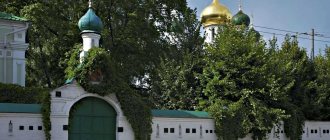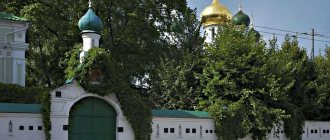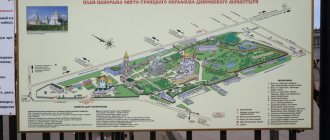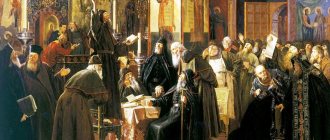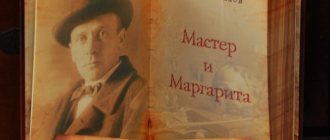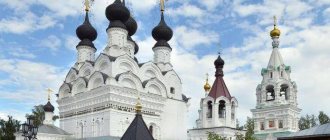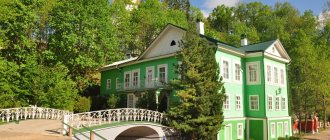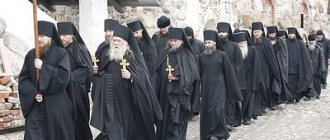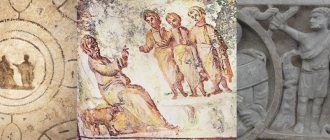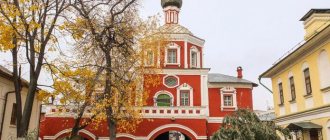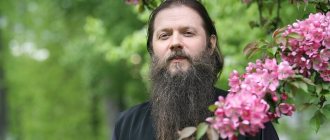She went to the monastery. Life and everyday life of the convent through the eyes of a “VM” correspondent
After the great Orthodox holidays, the VM correspondent, thinking about the meaning of life and how people come to God, went to the St. Nicholas Chernoostrovsky Monastery, which is near the Luzha River on the border of the Moscow and Kaluga regions. To find out what trials women who want to enter a monastery have to go through, I became a simple laborer for three days. This is the name given to the lay people who get work here in exchange for food and shelter. This is the first test for those who want to stay in the monastery forever. By the way, not everyone passes it...
WHAT NUNS ARE SILENT ABOUT
The first day. There is no running water in the main cathedral of the monastery. To collect water for cleaning and washing the floors in the temple (my first obedience), the nuns usually go to the cellar - it is in the residential building next door. A long, gentle staircase leads down and seems endless. In the very corner of the tiny room lined with white tiles is the treasured water tap.
“Come closer, don’t be afraid,” a woman’s voice was heard.
This is the nun Jerome in a black cassock. Carefully, slowly, she fills transparent flower vases with ice water to decorate the temple. My unexpected appearance does not bother my sister at all: people here have long been accustomed to workers like me...
—Are there no other exits from the cellar? — accustomed to the comfort of civilization, I ask. I really don’t want to climb back up the stairs with heavy buckets.
“No,” the sister shrugs.
There is nothing to be done - I head up the same long stairs. The road will be mastered by the one walking, spinning in his head. Running away from difficulties in a monastery is stupid. And that's not why I came here.
It's getting dark. The frosty January sky lights up with the first stars. Here, in this unhurried world, you pay closer attention to the appearance of stars in the dark sky. Plumes of smoke appeared from behind the trees outside the monastery wall - the locals were lighting the stoves in their houses. With buckets filled to the brim, I make my way through the high snowdrifts towards St. Nicholas Cathedral, where the nun Silouana is waiting for me.
“The assistant has arrived in time,” nun Silouana turns to me. She looks no more than 30. Graceful, slender figure - like a former ballerina, I think.
St. Nicholas Cathedral is filled with the fragrance of Athonite oils and myrrh. A lamp glows near the icon of St. Nicholas. The evening service had long since been served: apart from me and Sister Silouana, there was not a soul in the cathedral. The clock says 21:00. I take a rag, a bucket and a brush.
My mentor remains below, and I go upstairs, right under the dome. The choir (the place where singers and readers are located during services) is huge. There are chairs around the edges - for elderly nuns. On a wooden table in the corner there is a psalter and sheet music.
The chronicle of the St. Nicholas Chernoostrovsky Monastery contains more than one choir. But the current choir is special. The Byzantine chant, which the sisters use to perform church akathists, is a rarity not only in the capital, but also in Russia. The sisters learned this in Greece, from the famous Athos inhabitants of the Holy Mountains.
On major holidays there is no crowd here: all the sisters of the monastery, and there are no more than 108 of them (these are nuns, nuns, novices and schema-nuns), gather for the festive divine liturgy.
Having settled in the St. Nicholas Church, we move to the neighboring one - the Church of the Korsun Icon of the Mother of God. This is a large, bright church in the shape of a basilica, the iconostasis of which is decorated with wooden carvings.
The hearing takes place in complete silence. It is not customary to talk while working. The sisters also rarely talk to each other. I finally decide to start a conversation.
- And if, as they say, it’s boiling, who are you crying to? In the pillow? — I ask my sister Siluana.
“We reveal all our sorrows and joys to only one person - our mother abbess,” the sister reluctantly explains. “And when we enter the monastery, we tell her all our lives from birth.”
— Why did you decide to go to the monastery? Nun Silouana smiles.
She was probably asked this question dozens of times - by relatives, neighbors, friends...
“To be closer to God,” she answers. “But everyone’s reasons for leaving are different.
— What prompted you exactly? - I’m not far behind.
- Hatred of everything worldly! - she answers without hesitation.
Wow! Can a monk hate? But what about the love that Christ spoke about?
— The monk hates sin. And in the world there is especially a lot of sin that poisons the soul,” sighs the young nun.
—What is required from a believer to come to you and be closer to God?
“The doors to the monastery are open to everyone,” the nun humbly explains (this is what they call those who permanently live in the monastery). - Nikolai, Mother Superior, tries not to refuse anyone. Usually many pilgrims come to the monastery. They live for free, work in general monastic obediences, and attend church. Some stay forever.
—Have there been cases when sisters abandoned everything and ran away from the monastery?
Sister Silouana does not answer and points to the oiled candlestick, as if hinting that it is time to get to work. The conversation is over. We have to obey. Although in another place she would certainly start arguing. But not at this time. Not here. Not with this person. A monastery is a special world with its own strict hierarchy.
The workers are subordinate to the novices. They, in turn, must follow the instructions of the monastic clergy in everything. And the nuns themselves are directly subordinate to the abbess of the monastery, Mother Nikolai. There is also a special position here - dean. This is the right hand of the abbess. In office terms, Deputy Director. As it turned out later, all the tasks “flew” to me from the dean’s sister Seraphima.
LIFE OF THE monastery
The morning in the monastery, as always, began with the first rays of the sun. I see that the territory of the monastery is lively. The sisters hurry along snow-covered paths to St. Nicholas Church for common prayer. Then comes the cell rule - each sister prays in her own cell. At 9 am Divine Liturgy. Everyone takes part in it: nuns, novices, workers, parishioners.
Only at 11:30 is the first meal in the entire monastery! The nuns eat separately - in the sisters' building. Largely because their meals are strikingly different from the meals of workers. Everyone has the same menu, but their attitude towards food is different. The sisters call the meal nothing more than a continuation of the Divine Liturgy. Before eating food, they sing a prayer of thanks for the bread and salt given by the Lord. They do not eat meat in the monastery.
On holidays, fish is served on the table. But the menu always has a wide selection of dairy products: milk, cottage cheese, cheese. The monastery farm has 16 cows: black-and-white, Schwyz, Sychevsky and Holstein breeds. Next to the barn, the sisters run their own small dairy shop: here they roll their own cheeses, infuse fermented baked milk, bake cheesecakes and pancakes.
From 12:00 to 16:00 the sisters work in obediences. Monastic obediences are changing. Waking up in the morning, the sister never knows what front of work she will be entrusted with this time. In the summer, the sisters spend most of their time in the gardens: growing tomatoes in greenhouses and seedlings. In winter they work in workshops: they sew liturgical clothes, embroider icons, and paint churches.
At 17:00 the all-night vigil begins in the monastery. For every nun, worship is the central event of the day. Not a single painted fresco, not a single skillfully embroidered icon can compare in significance with prayer.
The last meal in the monastery is at eight in the evening.
From 23:00 to two in the morning, closed night services are held in the monastery. You can attend such a service only with the permission of the abbess of the monastery.
But not these days - now that I’m here, there are no night services on holy days. At such closed night services, the sisters pray for peace (including in Ukraine, they ask God for the health of loved ones).
“Sometimes you can get the impression of a routine: service, meal, obedience... Again service, meal,” says novice Maria. - But that's not true. One Athonite elder said: “You need to start your day as if you came to the monastery just yesterday.” The sisters of the monastery strictly follow this instruction.
Novice Maria, who seemed to be an older woman, actually turned out to be my age. Meek, humble, with a slightly hunched back, Mary bears obedience in the prosphora: she bakes bread and prosphora for worship. It turned out that she, like me, is a journalist by profession. But he is reluctant to remember life before the monastery.
— Do you have a TV? — I ask my question, realizing that it sounds strange here.
“No, my sisters don’t watch TV,” Maria answers indifferently. - This is not a healthy activity.
There is only one TV for the entire monastery in the monastery library. However, in the monastery there is simply no time to sit down and watch TV in broad daylight. All the books I brought remained unopened. My entire first day is busy until the evening.
FATHERS AND SONS
Second day. Unlike the nuns, I woke up at eight in the morning. I woke up with difficulty after yesterday’s obedience and rushed to the morning liturgy at nine. Meanwhile, the sisters themselves are as good as new.
By the way, there is not a trace of fatigue on their bright faces. After the service I go to lunch. I crave hot coffee. But the monastery menu does not include an invigorating drink. Only tea (and only green) or fruit drink.
When we arrived, the table was already set. Potatoes, buckwheat, fish cakes are steaming, vegetable salad with cheese and olives, monastery cottage cheese, bread and fruit are simply served. And the appetite is such that I am amazed at myself. But, of course, I remain modest.
Vladimir keeps me company at the table. He is the father of one of the novices: a 56-year-old man, a native of Belgorod. His cell is opposite mine; he lives in the bishop’s house. Usually special guests and relatives are accommodated there. The amenities are like those of a good hotel. The conversation develops on its own. I found out that Vladimir came to the monastery for the third year in a row: he missed his daughter. She is a novice here, she is 27, her name is Tanya. In the monastery, a girl is engaged in painting.
“The life of the monastery has always been shrouded in a mass of secrets and mysteries,” says Vladimir. “And there are even more misconceptions and prejudices around “those who have renounced the blessings of the world.” They say that old people go to the monastery to atone for the sins of their youth...
- What really?
“My daughter went to a monastery at the age of 25,” says Vladimir. - She is beautiful and smart. There was no end to the suitors. I remember how one entrepreneur courted her. A good man, not poor. And it seemed like they had love...
- So what - he met someone else? - I ask.
- What do you! No! One fine day, my daughter went, as they say, in company with a friend, to stay at the monastery for a week. And she stayed here forever. At first, my wife and I tried to dissuade her. We tried really hard! And she asked him point blank: “Dad, do you want me to be happy?” And what kind of father does not want happiness for his child? We have come to terms.
But another visitor, Antonina (she is from Moscow), could not come to terms with her only daughter leaving for a monastery. She still feels uneasy. Although five years have passed since that day, the woman secretly continues to hope that “her daughter will eventually come to her senses and return to the world.”
“Life passes you by,” she says with sadness in her voice. - Now Katenka is 25. She may still have time to get married and give birth to grandchildren. But instead, my beauty grazes cattle, cleans the barn...
Antonina's daughter turned out to be pretty and friendly. Her wide smile and kind big eyes radiate joy and harmony. Katya firmly decided for herself that her home was here. From other novices I learned that Katya was sick with an incurable disease. It was with this misfortune that she came to the monastery. Doctors predicted her death would come soon. As they say, the whole monastery began to pray for her. They begged. The disease has subsided.
I CALLED HER ANGEL
My third and penultimate day at the monastery turned out to be the hardest. But more on that later. Of all the nuns of the monastery, for some reason I remember Sister Philareta the most. The nun looks to be at least forty, and her huge gray eyes reveal her to be a very energetic person. I called her an angel. Filareta literally saved me from “death.” And it happened like this: when I returned to my cell after the meal, I found a note in the door. And in it: “You have been blessed to iron clothes. Ironing board and iron opposite.” I think, apparently, I tormented everyone here so much with my questions that they decided to communicate with me in writing - through messages. I enter the next cell, where there is a whole mountain of duvet covers and towels...
I'm starting to obey. After two hours of ironing, black dots began jumping in front of my eyes from fatigue, and the mountain of laundry did not decrease. It became very difficult: both physically and mentally. Then Sister Philareta comes in with an electric iron in one hand and a folding ironing board in the other. When together, things naturally work out. An hour later, ironing is almost complete... When she found out that I was a journalist, she asked.
—What will you write about?
— About what and how you live, how you relax, what you eat...
“So this is the most uninteresting thing in our life,” Sister Philareta grins. - What difference does it really make what you eat?
- What is interesting then?
“People should be interested in knowing how we pray, for example,” the nun explains. - But in general…
The sister thinks about it. Her gaze stops at my mobile phone, which I do not part with even here.
“Some people in the world consider us... strange.” People seriously believe that we live like in a prison. But in fact, a monastery is a garden for the soul and a prison for sin, and the world, on the contrary: for sin in the world there is freedom...
Then I thought for a long time about the nun’s words. I wanted to argue and agree with her at the same time. However, despite the obvious difficulties, I liked being in the monastery. Regularity, the opportunity to be alone with oneself, without haste and fuss - isn’t this what each of us lacks? On the day of my departure, I met the abbess, Abbess Nikolai. In the history of modern monasticism, she is a legendary person in every sense. Suffice it to say that in the early 90s, this strong, courageous woman, not afraid to take responsibility on her fragile shoulders, created the first Orthodox orphanage in Russia for girls, which today numbers 50 orphans. Our conversation lasted only a few minutes. A very long line lined up behind me for Mother’s blessing. But in these short minutes, the wise nun managed to read the whole gamut of feelings in my eyes: gratitude, admiration, surprise and at the same time confusion, a feeling of understatement.
- Thank you for working here with us. You have received a lesson in monastic life. “God bless you,” the abbess told me goodbye.
And we parted. With the caveat on my part that one day I will definitely return here again.
ABOUT THE AUTHOR
Ekaterina Goncharova is a correspondent for the newspaper “Evening Moscow”, a member of the Moscow Union of Journalists, an Orthodox activist, and a volunteer.
Monk - who is this?
A monk is one who has given his life to serving God. This is not his choice - but his calling. Many go to the monastery, and only a small part eventually become monks, since monasticism is not a skill that you can master, but destiny.
Read also: How to write with strikethrough font?
A monk does not stop living on earth, does not stop doing any work for the monastery or for people (this is called obedience), but every minute of his life is dictated by serving God, and not by earthly ideas, goals or ideals.
From now on, he strives to live like an angel, not a man. The only core and meaning of his life is prayer.
How is a monastic vocation different from a choice?
Why you don’t need to take monastic vows
Some believe that people who do not have a successful worldly life go to the monastery, for example, who were unable to start a family. In fact, a variety of people, of different ages and social status, become monks. Here you can meet many young and intelligent people who were quite successful in their “past life”.
There is also an opinion that people go to the monastery for peace of mind, to hide from the sinful world behind the monastery walls, where worldly sins and vices cannot penetrate. Father John Krestyankin (1910-2006) warned about this incorrect understanding of monastic life:
“You are looking for peace and consolation and for this purpose you are planning to go to a monastery. But I will remind you of the testament of the sorrowful person of the Russian land, our venerable father Sergius: “Prepare your souls not for peace and carelessness, but for many sorrows and deprivations.” Therefore, I assure you: your current difficulties, compared to those at the monastery, will seem insignificant to you.”
And the Monk Ambrose of Optina (1812-1891) often said:
“If there is a cartload of sorrows in the world, then there is a whole convoy of them in the monastery.”
